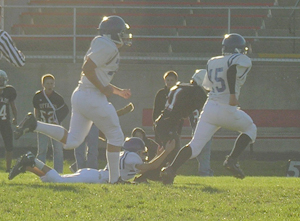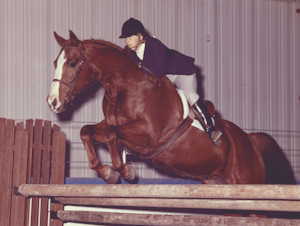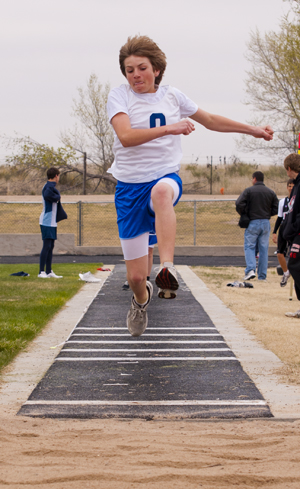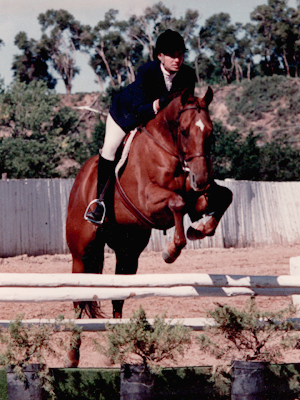I’ll admit I have mixed feelings about horse racing medications. I understand the need for therapeutic medication. Who hasn’t taken ibuprofen, naproxen sodium or aspirin on occasion? I was on Naprosyn for a year for a shoulder injury. I live with an asthmatic so I definitely understand the benefits of clenbuterol having lived with rescue inhalers for 26+ years. And Lasix has been proven beneficial in horses that bleed. But where do you draw the line? How do you know if a horse needs medication?

My son tackles an opposing player. He’s the one on the ground holding onto the black player. If you look closely you can see the ankle brace on his right ankle.
Middle School Football and a Teen-aged Boy
I’ve had a few heart-wrenching, eye opening experiences watching my children in middle school and high school sports activities. My eighth grade son hurt his ankle in football practice and was taken to the hospital for x-rays. The doctor, my dad, and nurse practitioner who looked at the x-rays didn’t see anything of major concern.
The radiologist who read the x-rays the next day did and since there was a visiting orthopedist in town we went to see him. He proclaimed that he had a fracture in his growth plate but it was not too worrisome. Although the thought of a fracture in the growth plate of a 13 year old boy sounded serious to this mother. He was put on Tylenol and ibuprofen, which he refused to take, and put in a boot for two weeks.
When the two weeks were up, and he had been walking on it, the orthopedist said we must have “over read” the x-ray. So he resumed light activity and injured it again in PE. The doctor who read this x-ray said it looked like he had an old fracture that hadn’t healed so we were back to the orthopedist who told him to stay off of it for another two weeks.
When he was finally allowed to play I remember watching him limp onto the field after being taken out for a play and thinking if he were a horse I wouldn’t ride him. But when I asked him about it he responded “but mom it doesn’t hurt.” Then why was he limping?
Middle School Track and a Teen-aged Boy
He’d reluctantly spent basketball season in an ankle brace and now wanted to stay in shape to run the two mile in track. Because we had so much snow that winter we got a tread mill. He wasn’t running so I asked him why. He responded his foot hurt when he ran. After about a month of this and consulting with my dad who now winters in Texas I took him to see another doctor.
Another x-ray. She said there was a small break, the radiologist said there wasn’t. He was put in another boot for 6 – 8 weeks. This one came off a week before his first track meet where he ran the in the 4×200 relay, the 1600 and triple jumped. He also asked the coach to scratch him from the 800 because he didn’t feel up to running anything else. But it amazes me that a 13 year old was able to do so much in such a short time.
How Horses React Differently to Pain
My hunter/jumper, Zandy Parr, had tender feet. He could be perfectly sound but if he stepped on a rock during his soundness circle I could be disqualified because he looked lame for a few steps. It didn’t take long to have the farrier put pads on him before I took him to a show where we knew there were a lot of rocks.
We finally gave up on another hunter/jumper. He had beautiful, possibly World Championship, form and would go great for a while then would just stop at the fences. We’d lay him off for a while and he’d be great again, for a short time. He was also one that would have a minor injury and be three-legged lame; he might not even come in to eat. We never did figure out if he had physical or mental issues or both. He was sold to be a trail riding horse.

Westbound Viejo, Dummy, jumping in Columbia, MO. Hmm, maybe the nick name is why he had those problems. Photo by Dan McClatchey Photography.
How do We Know?
My point is how do we really know when a horse is hurting so much that it shouldn’t compete? My son, who was obviously lame, said it didn’t hurt and went back on the field in one instance and asked to be scratched in another. The x-rays were apparently inconclusive since they were read differently by so many doctors. But he could at least tell us how he was feeling.
The horse can only tell us it hurts with its actions. Is it limping? Is it cranky or sensitive to touch? Medication can certainly help race horses recover from injury or help with a breathing or bleeding problem. But do we put them “back in the game” too quickly?
Olympic athletes who can tell us what they feel can be disqualified for a bad test and professional athletes probably push their bodies too far. How do we know we are not pushing our horses too far?
There is no way to be 100% sure. We can only have the vet run tests, observe their behavior and movement and use our best intuition. We do our best to make sure that they don’t break down on the track unfortunately sometimes our best isn’t good enough.
That’s my quarter’s worth. Let me hear yours by leaving a comment below.



Speak Your Mind